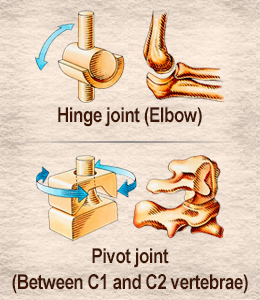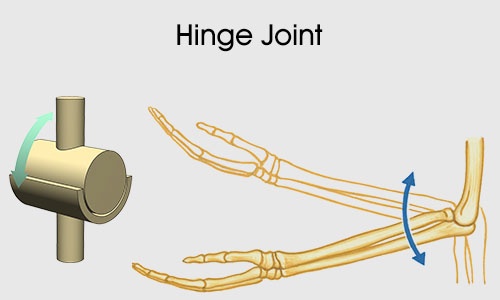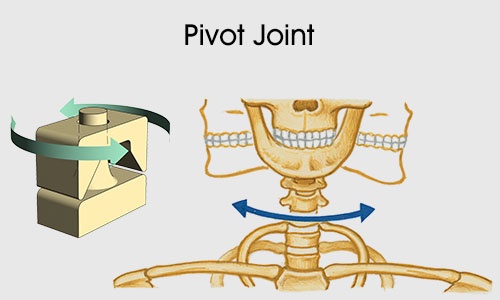An adult human skeleton comprises 206 bones. The point of connection between two or more bones is referred to as a joint. Not every joint in the human body is movable. While some joints allow limited movement, some don't allow any movement at all. This Buzzle post provides information about the function and examples of pivot and hinge joints in the human body.

Did You Know?The hyoid bone, a U-shaped bone that helps us swallow, breathe, and move our tongue, is the only bone in the human body that doesn't form a joint with any bone in the body.In anatomy, the term 'joint' refers to the articulation or point of connection between two or more bones. Joints not only hold the bones together, but also act as a supportive framework for the skeleton. They are classified on the basis of their structure and function. Based on the structure, there are three major types of joints, which include fibrous, cartilaginous, and synovial joints. This classification is based on the degree of movement, as well as the type of connective tissue that is present between the bones. Fibrous joints are fixed joints that don't allow any movement, as they don't have a joint cavity and the fiber that binds the bones is tough. The skull is an example of a fibrous joint. On the other hand, synovial joints are freely movable, whereas cartilaginous joints allow limited movement. The joints facilitate varied types of movements such as flexion, extension, abduction, adduction, circumduction, and rotation.
The joints between two vertebrae allow very limited movement, whereas synovial joints have a wide range of motion due to the presence of capsules that surround the articulating surfaces of the joint. The presence of the synovial fluid within the capsule prevents friction. Many of the joints present in the body are synovial joints. While muscle contractions enable the movements of these joints, ligaments help provide stability to these joints. These are further categorized into hinge joints, ball and socket joints, pivot joints, condyloid joints, saddle joints, and plane/gliding joints. The following paragraphs will shed some light on the structure and function of hinge joints and pivot joints, with the help of examples.Hinge Joint Location and MovementThe classification of synovial joints into hinge joints, ball and socket joints, pivot joints, condyloid joints, saddle joints, and gliding joints, is based on the shape of the articular surface of the bones in the joints. In case of hinge joints, the convex cylindrical articular surface fits into the corresponding concavity in the other bone. As the name suggests, this type of joint moves in a way that is similar to that of a hinge. It facilitates forward and backward type of movement only. Hinge joint function involves facilitating flexion and extension movements.
Flexion refers to the bending movement which decreases the angle between two parts. The examples of flexion include bending the elbow or making a fist. We also flex our knees to sit down. On the other hand, extension is a straightening movement that increases the angle between the body parts. For example, the fingers of the hand are fully extended in case of a handshake.
In a hinge joint, the surface of articular cartilage of one of the bones is somewhat cylindrical and has a depression. The articular cartilage surface of the other bone fits into this depression. The latter is a trough-shaped bone with a ridge. This type of joint allows for movement only in one plane around one axis.

Hinge joint examples include:
➠ Elbow joint (Humeroulnar joint)
➠ Interphalangeal joints
The humeroulnar joint is the meeting point of the humerus of the upper arm and the ulna (one of the long bones in the forearm). The knee joint, which is formed by the thigh bone (femur) and the two bones present in the lower leg (tibia and fibula), and the ankle joint are referred to as modified hinge joints. This is attributed to the fact that these joints allow a slight degree of rotation or side-to-side movement in certain positions of the limb. The knee is the largest hinge joint in the human body. The knee hinge joint is used while bending the leg and extending it to kick a football.Pivot Joint Location and MovementIn case of a pivot joint, the surface of the articular cartilage of one of the bones is rounded, whereas the surface of the articular cartilage of the other bone is ring or sleeve-shaped. The function of pivot joints in the body involves facilitating rotational uniaxial movement (movement that occurs around one axis) of the first bone around its own long axis.

Pivot joint examples include:
➠ Atlantoaxial joint is a joint formed by the first and second vertebrae of the neck. It facilitates the movement of the head from side to side or rotational movement of the head. The second vertebra forms the axis on which the first vertebra rotates.
➠ The radioulnar joint is a pivot-type joint, as the radial head rotates around at proximal ulna, whereas the distal radius rotates around distal ulna. The proximal radioulnar joint is formed by the articulation between the circumference of the head of the radius bone and the ring that is formed by the annular ligament and the radial notch of the ulna bone. The head of the radius rotates within the annular ligament. The movement of pronation and supination at this joint facilitate the up and down movement of the palm of the hand. The proximal radioulnar joint is located immediately distal to the elbow joint, whereas the distal radioulnar joint is located just proximally to the wrist joint. It is formed by the ulnar notch of the radius and the ulnar head. The ulnar notch of the radius slides anteriorly over the ulnar head during pronation and supination.On a concluding note, a pivot joint allows rotation of one bone around another, whereas a hinge joint facilitates flexion and extension movements, with a very small degree of rotation. Besides hinge and pivot joints, the human body comprises other types of joints such as ball and socket joint (Shoulder and hip joint), condyloid joint (wrist), saddle joint (carpometacarpal joint of the thumb), and gliding joint (acromioclavicular joint of the shoulder, articulations between the carpal bones of the wrist or between the carpals and the metacarpals of the palm).


 Did You Know?The hyoid bone, a U-shaped bone that helps us swallow, breathe, and move our tongue, is the only bone in the human body that doesn't form a joint with any bone in the body.In anatomy, the term 'joint' refers to the articulation or point of connection between two or more bones. Joints not only hold the bones together, but also act as a supportive framework for the skeleton. They are classified on the basis of their structure and function. Based on the structure, there are three major types of joints, which include fibrous, cartilaginous, and synovial joints. This classification is based on the degree of movement, as well as the type of connective tissue that is present between the bones. Fibrous joints are fixed joints that don't allow any movement, as they don't have a joint cavity and the fiber that binds the bones is tough. The skull is an example of a fibrous joint. On the other hand, synovial joints are freely movable, whereas cartilaginous joints allow limited movement. The joints facilitate varied types of movements such as flexion, extension, abduction, adduction, circumduction, and rotation.
Did You Know?The hyoid bone, a U-shaped bone that helps us swallow, breathe, and move our tongue, is the only bone in the human body that doesn't form a joint with any bone in the body.In anatomy, the term 'joint' refers to the articulation or point of connection between two or more bones. Joints not only hold the bones together, but also act as a supportive framework for the skeleton. They are classified on the basis of their structure and function. Based on the structure, there are three major types of joints, which include fibrous, cartilaginous, and synovial joints. This classification is based on the degree of movement, as well as the type of connective tissue that is present between the bones. Fibrous joints are fixed joints that don't allow any movement, as they don't have a joint cavity and the fiber that binds the bones is tough. The skull is an example of a fibrous joint. On the other hand, synovial joints are freely movable, whereas cartilaginous joints allow limited movement. The joints facilitate varied types of movements such as flexion, extension, abduction, adduction, circumduction, and rotation. Hinge joint examples include:
Hinge joint examples include: Pivot joint examples include:
Pivot joint examples include: